MILKING MADE EASY
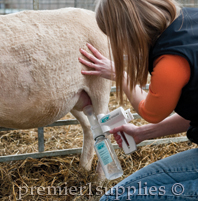
Using an Udderly EZ Milker on one of our ewes during lambing system. Works equally well on does. Very useful for milking small-teated does.
Udderly EZ™ Milker
Makes obtaining colostrum from a difficult doe or ewe less of an "athletic event."
A few pumps creates a vacuum allowing the teat valve to open and release milk. The flow is not rapid, but effective.
GOAT KNOW-HOW
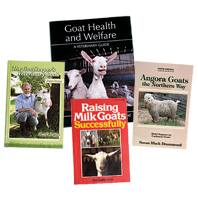 Add these useful goat books to your resource library:
Add these useful goat books to your resource library:
Goatkeeper’s Vet Book
By Peter Dunn. An addition to the British TV book series with their usual high-quality result. Hardcover. 230 pp.
Goat Health and Welfare
By David Harwood. Essential reading for all who care for goats. Hardcover. 175 pp.
Angora Goats the Northern Way
By Susan Black Drummond. Covers all aspects of Angora goat husbandry in cool or wet environments. Softcover. 220 pp.
Raising Milk Goats Successfully
By Gail Luttman, a nationally recognized expert with years of experience with milk goats. Softcover. 168 pp.
BE PREPARED FOR KIDDING
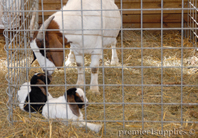
A typical kidding jug at Premier. Jugs allow the doe to form a strong bond with her offspring in a controlled environment and make it easy to provide assistance/treatment as needed to both doe and newborn kids.
Kidding jugs using Premier's Wire Panels
Select height (PowerBilt® panels 36" or 48" tall or our Standard panels 40") according to your animals’ behavior (wild vs relaxed, athletic vs calm) and your preferences (tall vs short).
We use connector hinges or braided nylon cord to tie jugs together and snap clips as latches.
|
 |
 |
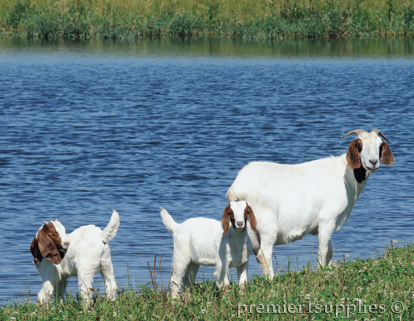
Proper Nutrition Leads to
Healthy Goats and Kids
Goats are voracious eaters of the seemingly unpalatable, as folks acquainted with goats already know. Other livestock turn up their noses at poison ivy and multiflora rose. Goats, on the other hand, will sweep through such browse and turn the unmanageable into tamed pasture. Though they still stop short of eating tin cans.
That varied diet is sufficient during the off-season when nannies are on a basic maintenance ration. However, during late gestation and lactation, they need to pack in the groceries. Below are a few articles from folks who know a lot about goats. The articles cover goat needs during gestation and lactation. We're pretty sure it involves more than just browsing weeds.
EXTENSION AND OUTREACH
Goat Feeding the Lactating Doe
Goats June 28, 2012
The lactating doe has very high nutrient requirements. Calculate the requirements for a 4-year-old, 110-pound Boer cross doe nursing twins in week four of lactation. When lactating is selected under question #2 on the Langston Interactive Nutrient Calculator (LINC), a form drops down. Select litter size (twins), week of lactation (4), and age at kidding (4). The program then predicts production of 4.5 pounds of milk per day with 3.6 percent fat and 3.3 percent crude protein. Nutrient requirements are 2.8 pounds of total digestible nutrients (TDN), 0.41 pounds of crude protein (CP), 7.61 grams of calcium, and 5.33 grams of phosphorus, with 4.14 pounds of dry matter intake predicted (based on default dietary TDN and CP concentrations).
During lactation, the doe can consume nearly enough nutrients if an abundant supply of high quality pasture is available, such as in spring or early summer. However, does will likely lose some body weight due to the high demands of peak lactation in weeks three to eight of lactation and an inability to consume an adequate quantity of feed. Kidding should take place when there is an adequate supply of high quality pasture. If there is not adequate pasture, supplemental feed will be required. Inadequate nutrition will decrease body condition, reduce milk production, reduce kid weaning weight and increase kid mortality.
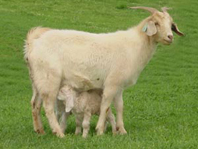
|
If feeding bermudagrass hay and a 16 percent dairy ration, 2.6 pounds of hay and 2.0 pounds of the ration are required to fulfill requirements. However, the doe will still lose 2.0 pounds of body weight per month. When fed high levels of grain such as the amount in this example, the animal should go through an adjustment period of two to three weeks during which time the grain portion of the diet is gradually increased to prevent digestion and other problems from occurring. Feeding a dairy ration and hay to a doe during late gestation and the lactating period will cost approximately $30 per animal. Utilizing available pasture as a feed source is a much cheaper alternative.
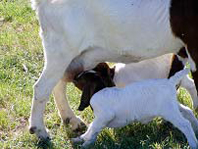
|
Kids are usually weaned at about 12 weeks of age. Milk production of the doe begins to decrease after the sixth week of lactation and is quite low by the 12th week. Nutrient requirements decline as stage of lactation advances, enabling the doe to maintain body condition or even increase it on pasture alone. Kids may be creep fed while nursing to increase growth rate and reduce nutrient demands on the doe for milk production.
Reference: Hart, S. 2008. Meat Goat Nutrition. Pages 58-83 in Proc. 23rd Ann. Goat Field Day, Langston University, Langston, OK.
© 2014 eXtension . All rights reserved.
EXTENSION NEWS
Feeding Dairy Goats
Laura Kieser, Extension Educator, Carver/Scott Counties
Published in Dairy Star April 30, 2010
Department of Animal Science
Copyright © 2013 Regents of the University of Minnesota. All rights reserved.
Goats are ruminants just like dairy cows. The four-compartment stomach is designed to digest large quantities of forages. Ruminants eat quickly and swallow their food at first without much chewing. Later, they regurgitate their food and thoroughly chew it and swallow. Healthy ruminants will spend as much time chewing their cud as they do grazing or eating hay.
Utilizing Pasture with Dairy Goats
Contrary to the popular image of goats thriving on tin cans, goats actually require a more nutritious diet than do other ruminants. Their shorter digestive system does not retain food for as long, and therefore does not digest nutrients fully. This quicker digestion allows them to eat larger quantities of food to make up for their reduced absorption of nutrients, but it is goats’ unique grazing behavior that really enables them to thrive on pasture. With their small mouths and flexible lips, grazing goats are able to select the highly nutritious parts of plants and leave parts that are less nutritious, giving them an advantage over cattle that graze which end up with large mouthfuls of various quality forage.
Each goat is able to consume up to 3 to 5% of its body weight in dry matter daily (perhaps more if the forage is highly digestible). To consume that amount, however, goats must be pastured in an area with a large quantity of available vegetative forage. Goats will eat less when they are moved to poor pastures. Goats prefer browsing (eating woody plants) but will also graze on grasses and weeds. Goats are known to stand on their hind legs to reach leaves and brush. Since goats, cattle, and sheep prefer different forages, in many pasture situations these species do not compete for the same food. Therefore, they can be managed quite successfully in a multispecies grazing system, allowing the land to be used more fully and generate more income.
Supplemental Feeding
While good quality forages are usually adequate, goats may sometimes need supplemental feeding, especially if they are producing high volumes of milk or during the winter. Goats need a proper balance of energy in the form of roughage or grain, as well as protein, vitamins, minerals, and clean water. Protein and energy requirements vary, depending on the type of goat and its stage of production (see Table 1). Dairy goats need both high-quality forage and supplemental grain to reach their full potential, especially during peak lactation or growth.
Read More »
|
|